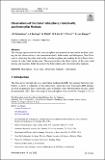Notice
This is not the latest version of this item. The latest version can be found at:https://dspace.mit.edu/handle/1721.1/142878.2
Observations of the Outer Heliosphere, Heliosheath, and Interstellar Medium
| dc.contributor.author | Richardson, J. D. | |
| dc.contributor.author | Burlaga, L. F. | |
| dc.contributor.author | Elliott, H. | |
| dc.contributor.author | Kurth, W. S. | |
| dc.contributor.author | Liu, Y. D. | |
| dc.contributor.author | von Steiger, R. | |
| dc.date.accessioned | 2022-06-06T13:37:04Z | |
| dc.date.available | 2022-06-06T13:37:04Z | |
| dc.date.issued | 2022-05-31 | |
| dc.identifier.uri | https://hdl.handle.net/1721.1/142878 | |
| dc.description.abstract | Abstract The Voyager spacecraft have left the heliosphere and entered the interstellar medium, making the first observations of the termination shock, heliosheath, and heliopause. New Horizons is observing the solar wind in the outer heliosphere and making the first direct observations of solar wind pickup ions. This paper reviews the observations of the solar wind plasma and magnetic fields throughout the heliosphere and in the interstellar medium. | en_US |
| dc.publisher | Springer Netherlands | en_US |
| dc.relation.isversionof | https://doi.org/10.1007/s11214-022-00899-y | en_US |
| dc.rights | Creative Commons Attribution | en_US |
| dc.rights.uri | https://creativecommons.org/licenses/by/4.0 | en_US |
| dc.source | Springer Netherlands | en_US |
| dc.title | Observations of the Outer Heliosphere, Heliosheath, and Interstellar Medium | en_US |
| dc.type | Article | en_US |
| dc.identifier.citation | Space Science Reviews. 2022 May 31;218(4):35 | en_US |
| dc.identifier.mitlicense | PUBLISHER_CC | |
| dc.eprint.version | Final published version | en_US |
| dc.type.uri | http://purl.org/eprint/type/JournalArticle | en_US |
| eprint.status | http://purl.org/eprint/status/PeerReviewed | en_US |
| dc.date.updated | 2022-06-05T03:11:00Z | |
| dc.language.rfc3066 | en | |
| dc.rights.holder | The Author(s) | |
| dspace.embargo.terms | N | |
| dspace.date.submission | 2022-06-05T03:11:00Z | |
| mit.license | PUBLISHER_CC | |
| mit.metadata.status | Authority Work and Publication Information Needed | en_US |
